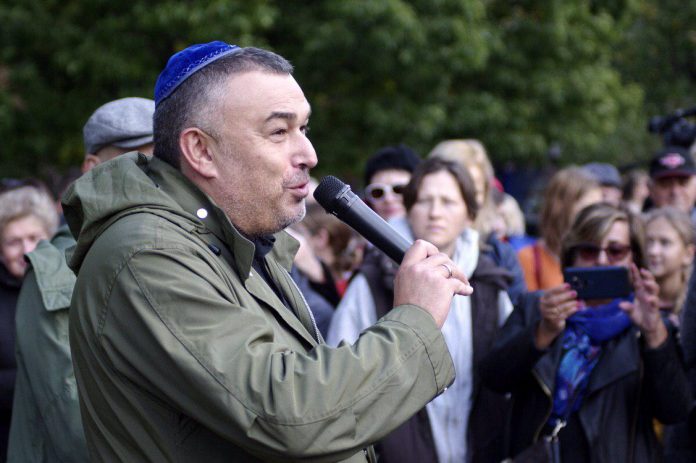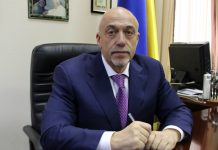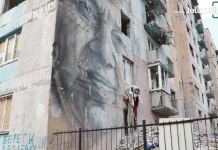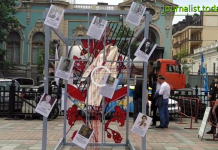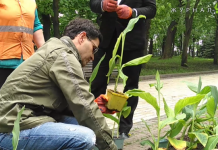Evhen Horodetsky, one of the founders of the March of Remembrance project, whose goal is to preserve and pass on to the younger generation the story of the victims of the Babyn Yar tragedy, has visited The Journalist’s studio. He told how the March of Remembrance project began and why it is important for his family to preserve the memory of people who were brutally murdered by the Nazis in 1941.
“The Babyn Yar tragedy 75th anniversary took place 4 years ago. This date was commemorated by a large number of guests, stands were built, a stage was constructed, and the president gave a speech. It seemed to me wrong and blasphemous. First, we must clearly understand for ourselves that Babyn Yar is a huge cemetery. It’s hard for me to imagine that for some events a stage is being built in the cemetery, beautifully dressed invited guests come and someone makes some speeches there. For me this is all too formal. I waited for all these normal events to end [events on commemorating memory of the victims of Babyn Yar in 2015 – ed.], got out of the car near the Kyivan Rus cinema (as I understand, it was there, near the Kyivan Rus cinema, where the main three columns from the places of compact residence of Jews in the city of Kyiv converged in 1941, namely, Pechersk, Jewish Market (Yevbaz) (Slavy square) and Podil; and from this point they were heading towards Babyn Yar). The first checkpoint was located near the motorcycle factory, there is now a memorial plaque. A single column was formed in the area of the Kyivan Rus cinema. And no one refutes me in this. Ukrainian historians, in particular, in Kyiv confirm this fact. And I went the same way to Babyn Yar, that people went in 1941. I posted some photos on Facebook and wrote about this. My friends and comrades have started to write to me. And we decided to do similar event next year. As a result, 97 people passed with me a year later. This showed me that there are public requests for the informalization of this process. This is a memory, something different for each person. We have decided to hold this informal event. My friend Dmytro Yurinov joined me for the second year already. We are organizing an event. Now Stella Kirtadze is still helping us. It costs us practically no money. For example, all expenses this year amounted just to USD 650. This money were spent to hire several buses to brought children from the schools of the Bila Tserkva and Zhytomyr. If the first time I was alone, after a year we gathered 97 people, then 350 people; this year we were about to gather 600 people. I really hope that there will be more of us. Although there is no such purpose, we do not collect people – they themselves come and go with us, everyone follows this road, about 3 km long, thinking about their own. We communicate, we talk, and children ask questions. There are always many children with us, this year there were about 150 of them. They ask: Why? What happened Why exactly these people? For what? The numbers of victims of Babyn Yar are terrifying. On the 29-30th (it still started on September 28th, the patients of the psychiatric hospital were executed first) 33,771 people and children under 3 years (who were not counted), and one more thing to understand is that 90% of these people were women. About 90% of executed were women, children and the elderly. Kyiv defended itself for a long time then, men were all summoned for service, and they went to the frontline. That is, we must understand that it was an unarmed mass of people who did not have time to evacuate, for some specific reason, they stayed in Kyiv and were executed there,” Evhen Horodetsky said.
In his opinion, the events in Babyn Yar should be remembered, because this is a documented mass extermination of people, in particular Jews.
“This is the first documented place of such mass extermination of people, in particular, Jews in one day or in a short period of time. In addition, it is clearly proved that these crimes involved not only specially trained SS forces [paramilitary groups of the National Socialist German Workers’ Party – ed.], not only collaborators, but also the Wehrmacht. Although the Germans claimed for quite some time that the army had nothing to do with it, but it was documented that army units participated in these executions. That is also extremely important to realize that there is no partial guilt. Therefore, I believe that what we are doing is a small chance that this will not happen again. Genocide, the destruction of people on religious, ethnic grounds, unfortunately, is a huge problem nowadays. The purpose of the March of Remembrance is to transfer the memory, he emphasized.
Evhen Horodetsky told how he found out about this tragedy when he was a child.
“When I was a child, I read Anatoly Kuznetsov’s book “Babyn Yar” [a documentary novel based on the author’s childhood memories. First published in 1966 – ed.]. This book I found in the house of my grandfather (my mother’s father). He was an illiterate man and worked as a crowbar driver, but he was a religious man. There were a very few books in the house, but among them was Kuznetsov’s “Babyn Yar”. In addition, our Soviet education, on the one hand, hushed up the tragedy of the Jewish people during the war, but on the other hand, this education gave us a lot of information. Now, unfortunately, children and youth do not know this story, this tragedy, causes and details of these events. Therefore, our task is to transfer memory further. For me, Babyn Yar is the beginning. I would really like for such marches to take place throughout Ukraine. We must understand that there are thousands of Babyn Yars in Ukraine, they are in every village, in every place, in every city, there are such places of tragedy, and even several. Because the executions took place in different places. Unfortunately, today, for various reasons, there are no longer those Jewish communities that retained this memory, people left. There are several American organizations that deal with such projects. Recently I was in Mirhorod, where the Holocaust museum was opened right at school. There is a Remember Us organization, which finances such projects. This is the 4th museum that they opened. Another American organization is engaged in similar projects aimed to put monuments in all places of mass executions of Jews in Ukraine, so that everyone can even visually understand what is being done there. Last year they opened the first monument in the city of Izyaslav (Khmelnitsky Oblast),” Evhen Horodetsky said.
He also emphasized that people from abroad come to the March of Remembrance every year, and each has its own history and tragedy related to Babyn Yar.
“This year there were people from Holland, Austria, USA. Diplomats always come to the March of Remembrance the second year in a row, as well as the representatives of German school, which works in Kyiv at the embassy. This year there were also OSCE representatives. People come up after the march with the words of gratitude. Last year was a very moving story. The march was on Sunday, a woman came up to me, and said: “Hello. I am 75 years old, from Israel. On Saturday morning my daughter called me, she lives in Kyiv, and said that on Sunday in there will be a March of Remembrance. So, I arrived in order to go with you.” Also this year there was a man who walked all the way with us and held the Estonian flag. They write a lot: from Australia, from the USA and Israel. If such things happen, then we have achieved what we wanted. Such events become events that touch everyone. The more people learned about this, the more people will think about it, read about the tragedy in Babyn Yar. In my family, quite a lot more than 20 people died in the pits. And therefore, how can I do not think about them. In addition, this tragedy touched my family and I fulfill my personal duty thanks to the March of Remembrance. In August 1941, part of my family was in Zhytomyr, and part in Kyiv. Most were in the capital. Here was such a man whose name was Haskil Osadchy, he was responsible for the evacuation of the equipment of the Artyom plant. He was married to cousin of my grandmother. This man, I don’t know how he succeeded, helped, and another car was attached to the train carriage with the equipment of the plant, to which more than 80 people who were members of ours arrived at the appointed time. And they left to Mozdok. But Haskil stayed in Kyiv because he was in the militia. In addition, in Mozdok, his older sister, who was also riding in this car, read that everything was fine in Kyiv, and returned to Kyiv, and later ended up in Babyn Yar. And it so happened that the Osadchy family saved everyone, and he, his brother and sister died (the men died at the front, and the sister died in Babiyn Yar). This is the story of my family, and every year people come with us whose relatives and friends were killed in Babyn Yar. That is why it is a huge cemetery. By the way, we are not just held the March of Remembrance, we held it on certain days, when you can go to the cemetery according to Jewish law. This year, the date of the shootings and the date of our event coincided. The next year it also coincides, and last year we went on October 7th. September-October is the period of Jewish holidays: New Year, Yom Kippur, etc. And we always ask the rabbi when to go,” he said.
In addition to the “March of Memory”, Evhen Horodetsky is engaged in another project that is dedicated to Mykola Blinov, a Ukrainian who defended the Jews during the pogroms in 1905.
“I believe Mykola Blinov should have become the idol of youth, because he personified everything that a young man should have. Yes, he fought against tsarism, he was a revolutionary. When he was aged 25, he had two children. He left the country to emigrate, because he was expelled from the institute. He was a student of the great Russian poet Sasha Chorny, with whom they traveled together to end hunger in the Volga region. I read a book about Blinov, which was written by the doctor of sciences, St. Petersburg writer Alexander Laskin, who, by coincidence, became interested in this story.”
(Mykola Ivanovich Blinov was born in 1881 in Zhytomyr. He studied at Kyiv University; after participating in student unrest, he went to Switzerland, where he continued his studies at the engineering department of the University of Geneva. In early 1905 he returned to his homeland and went to visit his parents in Zhytomyr. In April, Jewish pogrom began in the city, – ed.).
“Blinov had two children. His daughter married Tomashevsky, one of the greatest Russian Pushkinists. Accordingly, the writer Zoya Tomashevskaya is the granddaughter of Mykola Blinov. In her house, in the living room, members of the Saint Petersburg intelligentsia, namely, Aleksandr Solzhenitsyn, Sergey Dovlatov, Joseph Brodsky gathered. In the living room was a portrait of Mykola Blinov, and once Laskin became interested in the portrait. Zoya Tomashevskaya said that this was her grandfather, and told his story. Then Laskin began to search for information. What did Mykola Blinov do? His family lived in Zhytomyr, his father was a retired lieutenant, he died early; he has two brothers, they became police officers, and he became a revolutionary. And when the Jewish pogroms began, Mykola Blinov left St. Petersburg, left his wife with two children, arrived in Zhytomyr and went out to meet the rioters and was brutally killed: he was stabbed with bayonet 17 times.”
(Mykola Blinov went to the members of anti-Jewish pogroms for negotiations and was killed by a crowd. Mykola Blinov’s body was found by his mother in a morgue of a Jewish hospital as victims of street battles. In the 21st century, the tragic fate of Mykola Blinov became the basis for the documentary “The house is on fire, but clock is ticking” by Laskin, – ed.)
“It was 1905, and it is a symbol for me. And Zhytomyr Jews buried Mykola Blinov at the expense of the community. Moreover, a memorial plaque installed on the wall of the synagogue, which was destroyed by the Soviet authorities along with the synagogue. For a year, prayers were read in the synagogues, it is not often the case for Orthodox people to read memorial prayers in Jewish synagogues. Also, for the Blinov family, Jews raised money because the family was poor. His great-granddaughter Maria Tomashevskaya is alive, she lives in Moscow. She is a doctor of science, linguist. We communicate with her. I also communicate with Alexander Laskin. Last year, on the next day of the March of Remembrance, we opened a memorial plaque to Mykola Blinov in Zhytomyr, on Soborna Square, at the place where he died. This is amazing, but no one took a dime (designers, those who made the board). I am grateful to the mayor of the city, who did everything so that we could open this board. Now I have an idea, to name the segment of the street, where the memorial plaque of Mykola Blinov installed, after his name. It is small, there are only two houses. The Jewish Confederation of Ukraine picked up this idea. In Ukraine, there are streets named after the Righteous Among Nations, the people who saved Jews during the Holocaust. But, I believe that Mykola Blinov is more symbolic, because this fact was 35-40 years earlier. This indicates that there have always been people who are ready to protect the weak. It is very important. Accordingly, preservation of memory of them is very important,” Evhen Horodetsky summed up.
Подписывайтесь на telegram-канал journalist.today

